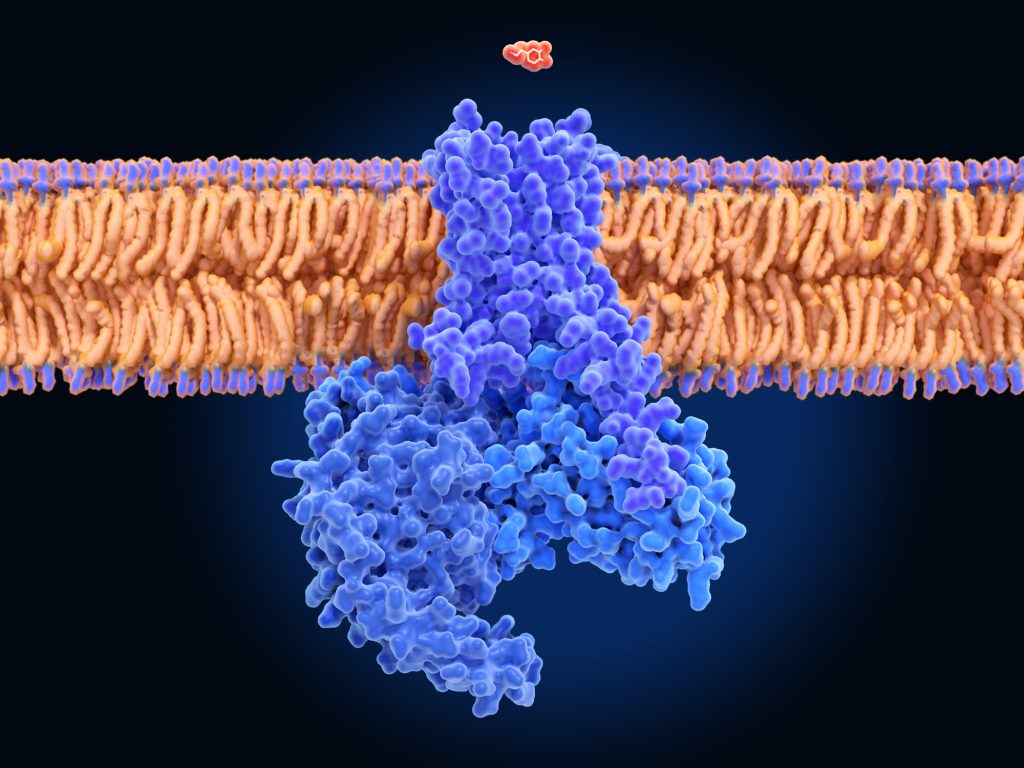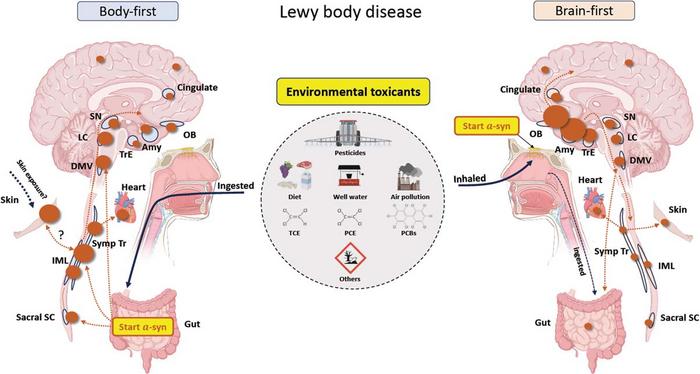For the past twenty years, researchers have debated the source of the toxic proteins at the source of Parkinson’s disease. In 2003, a German pathologist, Heiko Braak, MD, first proposed that the disease begins outside the brain. More recently, Per Borghammer, MD, PhD, with Aarhus University Hospital in Denmark, and colleagues argue that the disease is the result of processes that start in either the brain’s smell center (brain-first) or the body’s intestinal tract (body-first).
Now, a team of scientists, including Borghammer, have proposed a new hypothesis paper “The Body, the Brain, the Environment, and Parkinson’s Disease” that appears in the Journal of Parkinson’s Disease that unites the brain- and body-first models with some of the likely causes of the disease–environmental toxicants that are either inhaled or ingested.
The authors maintain that inhalation of certain pesticides, common dry cleaning chemicals, and air pollution predispose to a brain-first model of the disease. Other ingested toxicants, such as tainted food and contaminated drinking water, lead to body-first model.
Pathology linked to structures connected to the outside world
“The brain- and body-first models of Lewy body disorders predict that aggregated alpha-synuclein pathology usually begins in either the olfactory system or the enteric nervous system. In both scenarios the pathology seems to arise in structures that are connected to the outside world. Environmental toxicants, including certain pesticides, industrial chemicals, and air pollution are therefore plausible trigger mechanisms for Parkinson’s disease and dementia with Lewy bodies,” write the investigators.
“Here, we propose that toxicants inhaled through the nose can lead to pathological changes in alpha-synuclein in the olfactory system that subsequently spread and give rise to a brain-first subtype of Lewy body disease. Similarly, ingested toxicants can pass through the gut and cause alpha-synuclein pathology that then extends via parasympathetic and sympathetic pathways to ultimately produce a body-first subtype.”
“The resulting spread can be tracked by the development of symptoms, clinical assessments, in vivo imaging, and ultimately pathological examination. The integration of environmental exposures into the brain-first and body-first models generates testable hypotheses, including on the prevalence of the clinical conditions, their future incidence, imaging patterns, and pathological signatures.

The proposed link, though, has limitations and leaves many questions unanswered, such as the role of the skin, the influence of the microbiome, and the effects of ongoing exposures. Despite these limitations, the interaction of exogenous factors with the nose and the gut may explain many of the mysteries of Parkinson’s disease and open the door toward the ultimate goal—prevention.”
“In both the brain-first and body-first scenarios the pathology arises in structures in the body closely connected to the outside world,” said Ray Dorsey, MD, a professor of neurology at the University of Rochester Medical Center and co-author of the article. “Here we propose that Parkinson’s is a systemic disease and that its initial roots likely begin in the nose and in the gut and are tied to environmental factors increasingly recognized as major contributors, if not causes, of the disease. This further reinforces the idea that Parkinson’s, the world’s fastest growing brain disease, may be fueled by toxicants and is therefore largely preventable.”
Different pathways to the brain, different forms of disease
A misfolded protein, alpha-synuclein, has been considered as one of the driving forces behind Parkinson’s. Over time, the protein accumulates in the brain in clumps (Lewy bodies) and causes progressive dysfunction and death of many types of nerve cells, including those in the dopamine-producing regions of the brain that control motor function. When first proposed, Braak thought that an unidentified pathogen, such as a virus, may be responsible for the disease.
The new study argues that toxins encountered in the environment, specifically the dry cleaning and degreasing chemicals trichloroethylene (TCE) and perchloroethylene (PCE), the weed killer paraquat, and air pollution, could be common causes for the formation of toxic alpha-synuclein. TCE and PCE contaminates thousands of former industrial, commercial, and military sites, most notably the Marine Corps base Camp Lejeune, and paraquat is one of the most widely used herbicides in the U.S., despite being banned for safety concerns in more than 30 countries, including the European Union and China.

Air pollution was at toxic levels in nineteenth century London when James Parkinson, whose 269th birthday is celebrated today, first described the condition.
The nose and the gut are lined with a soft permeable tissue, and both have well established connections to the brain. In the brain-first model, the chemicals are inhaled and may enter the brain via the nerve responsible for smell. From the brain’s smell center, alpha-synuclein spreads to other parts of the brain principally on one side, including regions with concentrations of dopamine-producing neurons. The death of these cells is a hallmark of Parkinson’s disease.
The disease may cause asymmetric tremor and slowness in movement and, a slower rate of progression after diagnosis, and only much later, significant cognitive impairment or dementia.
When ingested, the chemicals pass through the lining of the gastrointestinal tract. Initial alpha-synuclein pathology may begin in the gut’s own nervous system from where it can spread to both sides of the brain and spinal cord. This body-first pathway is often associated with Lewy body dementia, a disease in the same family as Parkinson’s, which is characterized by early constipation and sleep disturbance, followed by more symmetric slowing in movements and earlier dementia, as the disease spreads through both brain hemispheres.
New models to understand and study brain diseases
“These environmental toxicants are widespread and not everyone has Parkinson’s disease,” said Dorsey. “The timing, dose, and duration of exposure and interactions with genetic and other environmental factors are probably key to determining who ultimately develops Parkinson’s. In most instances, these exposures likely occurred years or decades before symptoms develop.”

Pointing to a growing body of research linking environmental exposure to Parkinson’s disease, the authors believe the new models may enable the scientific community to connect specific exposures to specific forms of the disease. This effort will be aided by increasing public awareness of the adverse health effects of many chemicals in our environment. The authors conclude that their hypothesis “may explain many of the mysteries of Parkinson’s disease and open the door toward the ultimate goal—prevention.”
In addition to Parkinson’s, these models of environmental exposure may advance understanding of how toxicants contribute to other brain disorders, including autism in children, ALS in adults, and Alzheimer’s in seniors. Dorsey and his colleagues at the University of Rochester have organized a symposium on the Brain and the Environment in Washington, DC, on May 20 that will examine the role toxicants in our food, water, and air are playing in all these brain diseases.
The post New Theory on Parkinson’s Origins and Spread appeared first on GEN – Genetic Engineering and Biotechnology News.













